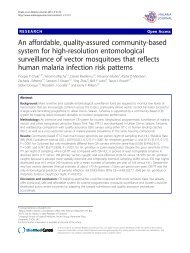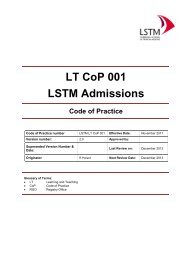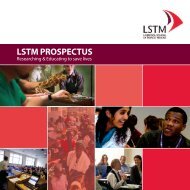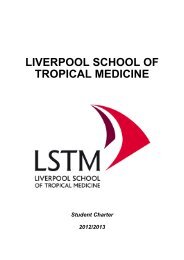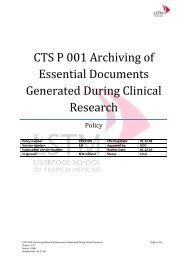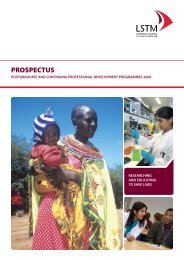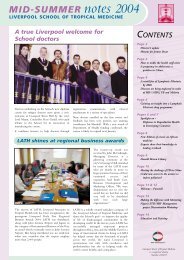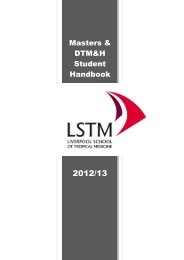Gender influences on child survival, health and nutrition: a ... - Unicef
Gender influences on child survival, health and nutrition: a ... - Unicef
Gender influences on child survival, health and nutrition: a ... - Unicef
Create successful ePaper yourself
Turn your PDF publications into a flip-book with our unique Google optimized e-Paper software.
<str<strong>on</strong>g>Gender</str<strong>on</strong>g> Influences On Child Survival, Health And Nutriti<strong>on</strong>: A Narrative Review<br />
2.2 ADDRESSING COMMUNITY PARTICIPATION<br />
The review has dem<strong>on</strong>strated that <strong>health</strong> service users face multiple barriers to facility care, some of<br />
which are specifically linked to dimensi<strong>on</strong>s of gender. As the diagram above dem<strong>on</strong>strates, women<br />
experience time poverty due to their heavier burden of ‘reproductive’ care, which is often coupled with<br />
other duties such as paid employment inside or outside the home. On the other h<strong>and</strong> men may feel<br />
discouraged to attend facilities with young <strong>child</strong>ren as communities <strong>and</strong> the facilities themselves often<br />
view maternal <strong>and</strong> <strong>child</strong> <strong>health</strong> care as a purely ‘female’ domain. Bey<strong>on</strong>d these gender-related factors,<br />
poor <strong>and</strong> isolated communities suffer through lack of access to primary <strong>health</strong> care facilities <strong>and</strong> lack of<br />
transport or, indeed, financial resources, to travel to distant facilities. In turn, women’s lack of financial<br />
independence <strong>and</strong> lack of freedom to travel may exacerbate these factors further. Communities may<br />
benefit then from <strong>health</strong> services that are delivered through more accessible <strong>and</strong> sustainable<br />
mechanisms <strong>and</strong> that seek to engage community members within their local c<strong>on</strong>texts. Outlined below<br />
are two examples of projects which have sought to engage with communities through participatory<br />
methods.<br />
A cluster-r<strong>and</strong>omised trial of a participatory learning <strong>and</strong> acti<strong>on</strong> cycle found positive <strong>child</strong> <strong>survival</strong><br />
outcomes for this type of interventi<strong>on</strong>, which focused <strong>on</strong> mobilizing women’s groups in Jhark<strong>and</strong> <strong>and</strong><br />
Orissa, eastern India (Rath et al. 2010). The interventi<strong>on</strong> was carried out in 18 cluster sites, 12 of which<br />
were in isolated rural communities, where newborn <strong>health</strong> outcomes were particularly poor. In these<br />
communities women have little access to primary <strong>health</strong> care facilities <strong>and</strong> delivered in 80% of cases,<br />
without a skilled birth attendant. The interventi<strong>on</strong> involved 20 meetings with women’s groups based <strong>on</strong><br />
participatory learning <strong>and</strong> acti<strong>on</strong> methods. The interventi<strong>on</strong> sought to address supply-side <strong>and</strong> dem<strong>and</strong>side<br />
issues by combining learning activities such as participatory games <strong>and</strong> strategies with strategies to<br />
address <strong>health</strong> funds, stretcher schemes, producti<strong>on</strong> <strong>and</strong> distributi<strong>on</strong> of clean delivery kits, <strong>and</strong> home<br />
visits.<br />
The interventi<strong>on</strong> led to a 45% reducti<strong>on</strong> in ne<strong>on</strong>atal morality in the last two years of the interventi<strong>on</strong>,<br />
which the study was largely due to improvements in safe practices for home deliveries. The authors<br />
hypothesised that this improvement was based <strong>on</strong> the following six interrelated factors: (1)<br />
acceptability; (2) a participatory approach to the development of knowledge, skills <strong>and</strong> ‘critical<br />
c<strong>on</strong>sciousness’; (3) community involvement bey<strong>on</strong>d the groups; (4) a focus <strong>on</strong> marginalised<br />
communities; (5) the active recruitment of newly pregnant women into groups; (6) high populati<strong>on</strong><br />
coverage.<br />
An important aspect of the interventi<strong>on</strong>’s success was that other members of the community became<br />
involved in the groups throughout its implementati<strong>on</strong>, leading to broader learning <strong>and</strong> engagement with<br />
other households members such as husb<strong>and</strong>s <strong>and</strong> adolescent girls or unmarried women thus reinforcing<br />
learning more widely. However the authors point out this broader engagement was at times<br />
challenging, when facilitators had to address sensitive topics in the presence of men, for example.<br />
Aubel et al. (2004) provide an evaluati<strong>on</strong> of an interventi<strong>on</strong> focused <strong>on</strong> gr<strong>and</strong>mothers’ involvement in<br />
improving maternal <strong>and</strong> <strong>child</strong> nutriti<strong>on</strong> (Aubel, Touré & Diagne 2004). The authors usefully identify<br />
ways in which gr<strong>and</strong>mothers have been left out of the equati<strong>on</strong> in mother <strong>and</strong> <strong>child</strong> <strong>health</strong><br />
programming, due to percepti<strong>on</strong>s that they are not influential in household decisi<strong>on</strong>-making, or that<br />
they are associated with ‘traditi<strong>on</strong>al’ remedies c<strong>on</strong>sidered harmful, or that they are incapable of<br />
53



